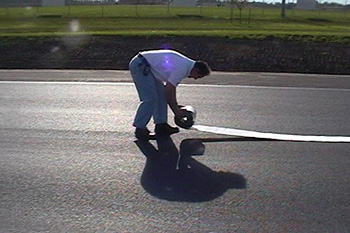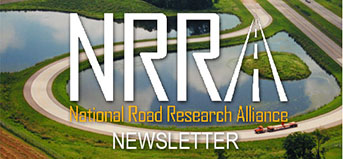NRRA Newsletter: March 2019
2019 NRRA Pavement Workshop
Please plan to attend this year's NRRA Pavement Workshop.
- Registration is open.
- We have an App for the workshop.
- Both FHWA Vans--asphalt and concrete--will be on hand.
- We've added an extra day. May 21 will showcase "BIM for Pavements... Asset Management, Planning, Design and Construction."
- The agenda is nearly done.
North Dakota DOT Case Study: E-Ticketing
When it comes to adopting new technology, the ability to learn from someone who has already tried it is invaluable. North Dakota DOT has tried eight projects using e-ticketing, and here’s what they learned.
Jesse Kadrmas, Transportation Engineer Manager/Team Lead for NDDOT, explained how the agency was working on reducing paper, so e-ticketing was a natural step in that direction. The idea behind it is to take some of the paperwork associated with a construction site—namely the tickets that the truck drivers pick up at the plant and deliver to the ticket taker at the paving site--and put that online and up in the cloud. That prompts at least a couple of questions:
- What happens when you automate this step in the construction?
- Are there additional benefits to eliminating the paper?
Kadrmas said the most immediate significant benefit to e-ticketing is safety, because the ticket taker is no longer in harm’s way. “They probably have one of the most dangerous jobs out there, jumping up on the truck and grabbing the ticket,” he says.
Another benefit is real-time data. This helps the contractor supervisor know where the trucks are, what the output of the plants are, timing, and any breakdowns in the chain. In the pilot projects, the contractor could choose what data to pass on to the DOT engineers. Kadrmas said the important things his team wanted to know were the tracking data of the trucks as they moved, and the ticket data in real time. The system they used allowed the DOT workers to add notes to each ticket, such as temperature and waste.
In the first pilot project, Kadrmas said they did have back-up hard copy paper tickets being used at the same time as the e-ticketing. After that, they went to straight e-ticketing for the other 7 projects. Here’s a checklist of things that had to be in place to make the system work.
Connectivity: While a lot of North Dakota is rural, Kadrmas said they didn’t run into too many connectivity issues. The asphalt plants themselves had to be online constantly, so one of them in a valley near Devils Lake needed to add an antenna to stay connected to the Cloud. The trucks could go in and out of coverage areas and the system would fill in the dots where they lost connectivity.
GPS Units: The trick was making sure each truck had the right tracking number up front. With some trucks working multiple project sites, constantly monitoring them was a challenge. The GPS units themselves were either hardwired into the truck or plugged into the lighter. The plug-in units also had a backup battery, so even if drivers unplugged them, they were still being tracked.
Modems: They used a Cradlepoint modem for the data; mobile hotspots don’t work. Also make sure the contractor has a dedicated technology person who will keep the system up and running.
Kadrmas said the next step is to try projects in western North Dakota. Then NDDOT will try to get more contractors on board and using the e-ticketing system for all projects. One drawback, he says, is some of the older asphalt plants are still running the DOS operating system. They at least need a Windows machine for any of this to work.
Pavement Research Resources
- Tensar's Road Show will be in Minneapolis on April 10 for an examination of geogrid. Our own John Siekmeier will be presenting. Here's a list of other dates and cities.
- Report from the Missouri DOT titled: Field Implementation of High-Volume Recycled Materials for Sustainable Pavement Construction
- Webinar by the National Park Service on Pavement Preservation: Repair Road Edge Stabilization is happening on April 4.
- Articles by Ben Worel and Jerry Geib appeared in the spring issue of the Pavement Preservation Journal.
Every Day Counts Peer Exchange: The How of Pavement Preservation
On February 27 and 28, 2019, MnDOT hosted a peer exchange for the Every Day Counts initiative, sponsored by the FHWA. Earlier peer exchanges focused on the “why” and “where” of pavement preservation, but this event was dedicated to the “how” of maintaining good roads.
Representatives attended the meeting from DOTs including Wisconsin, Iowa, Missouri, as well as about 30 people attending online via Skype. As meetings go, these peer exchanges are quite unstructured. Each hour is dedicated to a topic and everyone in the room is expected to share their best practices, their frustrations and even their failures. As Kevin Kliethermes, Pavements and Materials Engineer for the Minnesota Division of FHWA, puts it, “we get the appropriate people talking, about the appropriate applications for maintaining a pavement program.”
Topics of the exchange included: chip seals, micro surfacing, cold in-place recycling, life cycle costs, concrete partial depth repairs, ultra-thin bonded wearing course, quality assurance, scrub seals, precast slabs and diamond grinding, and lastly, cape seals.
The open structure of the meeting, says Kliethermes, lets everyone put their cards on the table. Attendees are asked to share their learning experiences, not only the good or best practices but also those that did not go as expected. In this manner, everyone can learn from those experiences. The peer exchange is all about sharing each other’s knowledge of and experiences with pavement preservation.
Here were some of the discussions that stood out for Jerry Geib, Research Operations Engineer for MnDOT:
Chip Seals—If you are wondering how specific the discussions got, Geib says the comment that one agency was using CRS 2 emulsion versus the CRS 2P (with polymer) was important to him. Apparently that difference may decrease stripping under the chip seal.
Knowledge Books—See last month’s newsletter.
Pavement Preservation Checklists—This is a series of checklists from FHWA and the Foundation for Pavement Preservation, developed in the early 2000’s, to assist inspection and construction staff in performing reviews on a variety of pavement preservation applications. The checklist is expanding from the current series of 14 applications up to 23 soon.
Emulsion Task Force—this group is creating material specifications for all kinds of surface treatments—scrub seals, microsurfacing, etc.
For Kliethermes, the over-riding goal for these peer exchanges is to encourage pavement preservation for states to achieve long life for pavements. This program is part of FHWA’s goal of managing pavement performance, along with asset management. Most of states are having to deal with the management of their pavement programs with a funding shortfall.
One of the less concrete benefits of the peer exchanges is making connections with peers in other states. “Getting to talk to and see a friend--or meeting someone new--is one of the big benefits that somehow pays off down the road when you need to call someone that you wouldn’t have met before,” says Geib.
Longitudinal Joint Sealant: Illinois Case Study
In our January issue we talked about longitudinal joint construction and mentioned that some states used a joint sealant. In 2001 Illinois DOT actually created, with the help of some vendors, a joint sealant that has produced remarkable results. And these results go contrary to the conventional wisdom of joint construction.
Jim Trepanier, Engineer of HMA, Aggregate & Chemical Tests for IDOT, was looking at his agency’s poor longitudinal joint performance and started thinking. A top down sealant wouldn’t work as it would just end up with a pool of sealant on top of the centerline, which would have an adverse effect on pavement markings. He had noticed on some paving jobs there were places where extra tack coat went down, such as at the beginning of a tack run, the thicker tack would bleed to the surface. He thought if this concept was used on the joint it would fill the high in-place void region of the centerline joint, thus reducing the permeability to air and water.
The trick, he knew, was figuring out how to get this heavy application of tack material applied in a narrow band at the centerline to be soft enough to melt and migrate upward once overlaid. But it also had to be stiff enough to stand up to construction traffic crossing it without picking it up prior to being overlaid with the surface course.
The first product he looked at was a crack filling over-band material from Hendy Products. They had a crack filling product that was a thick preformed band of asphalt binder that was placed over cracks and melted into the crack using a torch wand. This product appeared to be stiff enough to allow traffic without pickup. After some experimentation with constructability and permeability testing with short sections of the Hendy product, the test sections appeared to have substantially lower permeability and good edge restraint for the unconfined paving edge. This prompted IDOT personnel to reach out to both Hendy Brothers and Asphalt Materials to collaborate on formulating Longitudinal Joint Seal (LJS). They worked to have the same desired stiffness as well as improved migration into the layer of asphalt placed over it, thus further reducing permeability.
 |
 |
| Photos of both products being installed 2001. |
In 2001 after formulations for both products were improved through trial and error migration testing at IDOT’s Central Bureau of Materials, demonstration projects were constructed using both the Hendy Products “QuickSeam” and Asphalt Materials “J-Band” products. The Quickseam was placed as two separate 9 inch wide 3/16 inch thick bands. The first band was placed such that the outside edge lined up with the unconfined edge of the surface course placed over it. Once the surface course was placed over the first 9 inch wide band, the second 9 inch wide band was placed adjacent to the newly placed mat with the centermost edge being lapped up onto the vertical face of the unconfined edge. The adjacent lane was then placed over the second band. Asphalt Materials applied their product in liquid form pumped from a heated kettle trailer into an 18 inch wide drag-box.
And they waited.
Districts were not interested in spending the extra money on additional projects utilizing LJS until they knew whether it would improve centerline joint performance and was cost effective. That is until more than a decade later when Steve Robinson, the Materials Engineer from District 5 took a photo in 2014 of one of the test projects located in his district. The joint was so good it immediately got their attention. “It wasn’t until we saw the compelling photos 12 years later that it reinvigorated our interest in it,” says Trepanier. The performance prompted them to go with full implementation of their LJS over the next three years.
Trepanier added “we had horrible joint density back then but amazing performance…you can’t argue with performance.” Illinois’ current LJS specification does not require density to be measured within one foot of the longitudinal joint when LJS is present due to the effect the higher asphalt content has on the Maximum Theoretical Gravity of the mix (Gmm).
The LJS that Illinois created is now being used all over the state. Indiana is also using it and so is Pennsylvania. Trepanier says the joints using this technique are significantly outperforming the rest of the pavement by a margin of 3 to 5 years.
There two reports on this project that will be publicly available soon. Please contact Jim Trepanier if you want a copy.
Research Pays Off April
Our webinar series on April 16, (10 a.m.) will discuss diamond grinding results in Texas, with Feng Hong from the Texas Department of Transportation.


